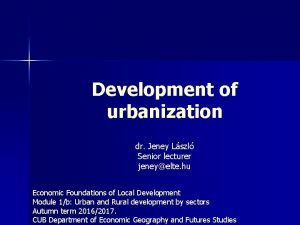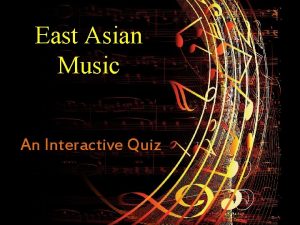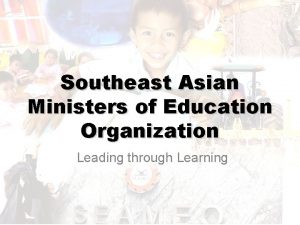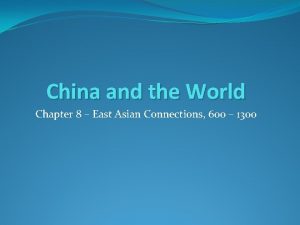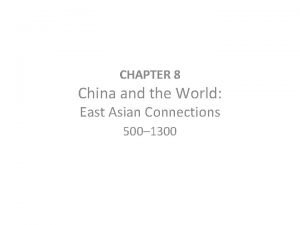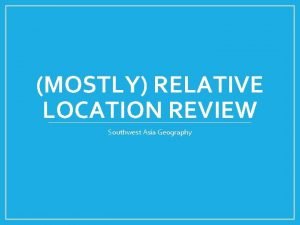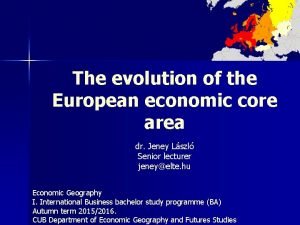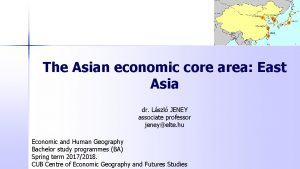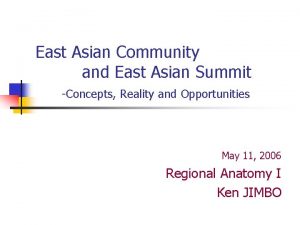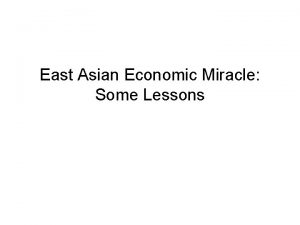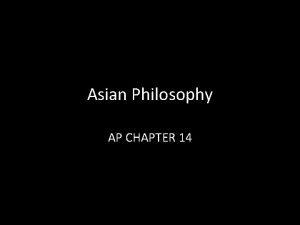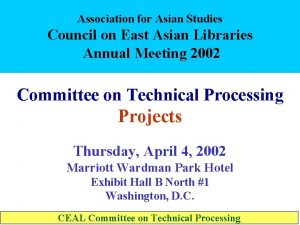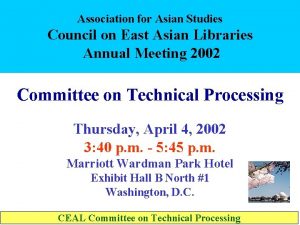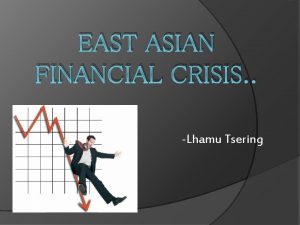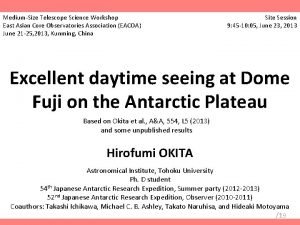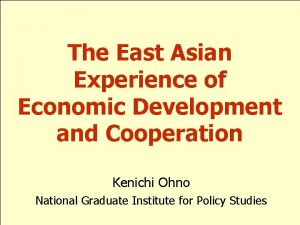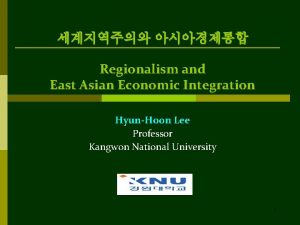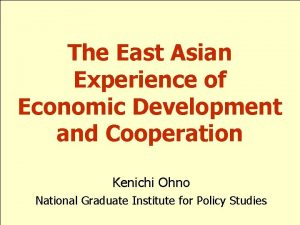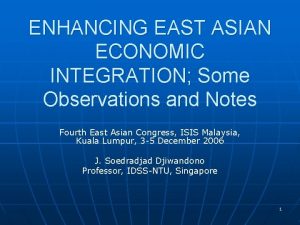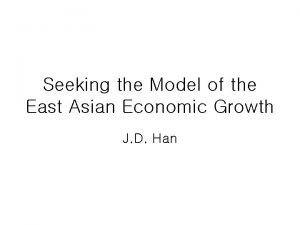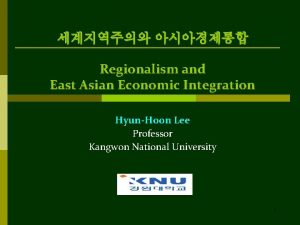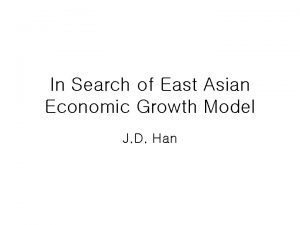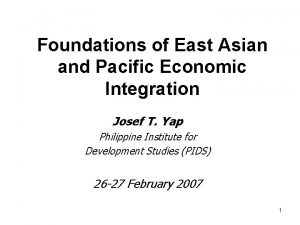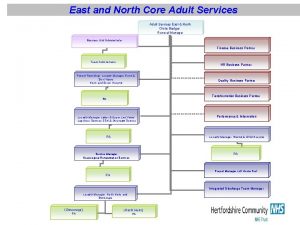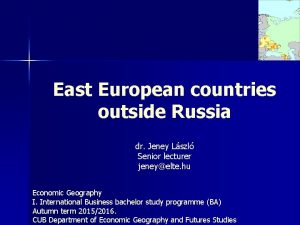The East Asian economic core area dr Jeney

























- Slides: 25

The East Asian economic core area dr. Jeney László Senior lecturer jeney@elte. hu Economic Geography I. International Business bachelor study programme (BA) Spring term 2015/2016. CUB Centre of Economic Geography and Futures Studies

The area of the East Asia and Far East n Far East < East Asia – Northeast Asia (Siberia, Russian Far East) – East Asia (Japan, Korea, China, Mongolia) – Southeast Asia (Mainland SEA, Insular SEA) n Its borders – n Debatable towards North and Inner Asia (Siberia, Mongolia, NW China, Tibet) Large World region: East Asia – Territory: 12 mn km 2 (8% of the World) 2 – Population: 1, 6 bn (23% of the World) WR 1.

East Asian miracle n Parts of East Asia – – – n n Largest part China (≈ Europe, 9. 6 km 2, WR 3. ) East + Inner Asia (Tibet, Uygur region) Tajvan, Hongkong (NIC 1) Korea South (NIC 1) and North: middle size Asian country, 222 th km 2, 75 mn residents (N–S: 1127 km, W–E 645 km) Japan Mongolia Late 20 th century: reemergence of East Asia Political, economic and cultural impacts Refocuses the global economic growth and political power on the Pacific Region Interactas to the globalization trends 3

The Japanese way to the economic miracle

Japan: more than 2000 years old historical past n Till the early 18 th cent. XVII. : empires (tenno) – Cultural and trading relations to other East Asian areas (mainly China, but Korea as well) – Capital: Kyoto n Power of army (leader shogun) totally isolation (dynasty of Tokugawa shogun) – Centralized, on feudal basis – Capital: Edo (today: Tokyo) n Late 18 th century: unsuccessful economic contacts by Europeans – Mid-19 th century: successful contacts by the USA – Followed by the English, Dutch, French, Russian traders n 1868– 1912: restoration of the power of empire (Mutsuhito tenno) – Meiji period 5

Reforms of education n n Till that time the majority of society was analphabetic Introduction of compulsory elementary education (earlier than more developed countries) – 1880 s: 6– 13 years old boys 54%, girls 19% attended school – 1900: 95% alphabet n More skilled manpower adoption of Western technologies 6

Meiji reforms: civil change, rapid catch-up n n Instead of feudal system former peasantry cheap manpower for the modernizing economy First manufactures – Initially capital concentration in the richest feudal families monopole organisations n Important role of state – – – Stabilization of the capitalist order Central Bank: development of heavy industry, transport Cancellation of the feudal social hierarchy New administrative system (46 prefectures) Permission of free movement of citizens Cancellation of inner tolls single market of the country 7

The East Asian economic Miracle n The only one world region in the focuses of the world economy starting not on the basis of the Western civilization – Maintenance of its own culture and traditions n Japan: the way to the economic power – Under a historically uneven short period – An outstanding rapidly growing economy for decades n n Korea, Taiwan and Southeast Asia: follow the Japanese sample China: political-military, cultural, and increasingly economic power 8

The Japanese economy changed massively after WWII n n n Post-war period: present government, economy and constitution were put in place 1960– 1990: contribution to total world GDP grew from 3. 5 to 14 % 1960– 2002: – Primary sector declined from 33 to 1 percent – Service sector rose from 38 to 68 percent n From 1990 s: Japanese economy slowed – China’s GDP 1. 5 times higher – But per capita GDP remained much higher in Japan ($35. 000) than in China ($6. 000) 9

After reconstruction n Reconstruction – WWII: Japanese industry destroyed – After war: US poured money to rebuild the industries and infrastructure – Cold War, Communist takeover in China, Korean war US became opened to Japanese products n n Advantageous environment for Japan Cheap raw material on world markets – Transportation innovation: building large oil tankers and carriers (oil from SW-Asia, iron ore from Australia) n n Own low-cost, young labour force 1960 s: 10 % economic growth Firms indorsed profits back into new developments Better wages Japanese consumers could buy a range 10 of home-made products

1970 s: increasing costs and „just in time” n n 1970 s: increased oil prices – – Japan depended on imported oil for 70 % energy needs reduced costs of hydroelectricity and nuclear power – – Factory closures social problems, unemployment (e. g. Osaka) Investments to light industries (producing cameras, household appliances) Firstly copied others’ technologies and designs, later initiator Older industries (steelmaking, shipbuilding, petrochemicals, cement making) suffered from overcapacity on world markets – n n By 2000 half of the world’s industrial robots (4 x installed than in the US) „Just-in-time” deliveries cut warehousing costs – n Toyota: employed more human skills instead of indiscriminate use of robotics ( too expensive) 1980 s huge export income caused the yen to double in value compared to other currencies – – Japanese export became more costly for other countries Imports became cheaper 11

From 1980 s: global investments n n Large yen trading surpluses Japanese corporations invested more Firstly: bought out foreign mineral suppliers Later: established Japanese factories abroad Answer to quotas on import of home-made cars – First major investments in US and GB, from late 1980 s then in Southeast Asia economic growth of NIC countries – Mid-1990 s investments in cheap-labour assembly-line factories by moving design and research facilities to SEA – Early 2000 s: increasing investments in China (mainly to Dalian) – huge trade deficit to China 12

Renewed economic challenges n n n n Early 2000 s: J faced a need to change Investments resulted huge debts banking system under pressure Western countries imitated Japanese production processes (Toyotism) Japan looked more closely at Western ways in relation to financial control Trade surplus rapid growth of financial and business services 1986: Tokyo became the second financial centre further population increases Increase in service occupation widened range of employment 13 Diversified economy not so dependent on fluctuations of world markets

The developing East Asian giant: China

1949– 1976: Attempted Geographic Shifts n Initial attempts of the Communist Government (Mao Zedong): Great Leap Forward + Cultural Revolution – – n Expand output rapidly Distribute economic activities Equality within China Enhance national defence 1949: NE + Shanghai + Tianjin: 70% of output – Move the production of military goods inland – Factory locations close to the raw material sources (coal, hydroelectricity, oil) n Poor transportation linkages Central and W China developed slowly – Manufacturing production remained in NE n 15 1978: economic output of China < S Korea or Taiwan

Changing directions after 1976 n Deng Xiaoping: 1977 overall economic reforms – – – n After 2000: further revolution based on telecommunication systems (use of internet and mobile phones) – – – n „ 4 modernizations”: agriculture, industry, science, defence new approach to rural life Encouraged investment from foreign corporations Increasing manufactured exports Economy multiplied six fold within 20 years 1990– 2000: telephone lines 10 125 mn 1995– 2010: mobile phone users 5 800 mn (WR 1) Sensitivity of state control of website content China does not follow the Asian sample – – Asian NIC countries: 1. raw materials and food export, 2. simple manufactured than 3. more sophisticated goods, 4. service industries China: all typed of goods from rice to microchips 16

Farming and rural living in the 2000 s n n Agriculture: prominent in the rural economy Through Mao Zedong years: farming – – n n n Low levels of mechanization high labour inputs 1980: agriculture still employed the entire – growing – rural workforce Early 1980 s: relaxed commune controls individuals and groups plan their own programs – n Low govermental priority Separated from other aspects of the economy Personal involvement higher output 2000: half of the rural workers in farming

Rural industrial expansion n Township and village enterprises (TVEs) – – n Driving forces – – n New rural sources of income Took underused rural labour Higher wages 130 mn employees (30% of rural workforce) Initially: collectively owned enterprises (by late 1980 s: from 22 to 36 % of Chinese industrial output) Later: individual and private enterprises Millions of people remained in industrializing rural areas – BUT: many millions more moved out of the rural areas to the cities

Manufacturing n n 22% of labour force, half of GDP Standing on two legs: ancient-moderns, small-large Huge development during the last four decades Regional locations: – Before the revolution n n Textile and food industry, ports Steelmaking (Japanese): Northeast – First three decades of socialist industrialization n Inner parts of the country, regional equalization – From 1979: opening policy n High-tech industries, ports again, increases regional differences

4 important industries n Traditional – Textile and clothing industry (16%): sea coast (Shanghai), inner parts – Food industry (10%): areas producing raw materials, sea ports n Rapid developing – Machinery (30%): capital, ports, special economic zones – Chemistry (10%): coal mining areas, oil refineries (Daqing) n Other industries – Iron and steel industry: Anshan, Shanghai – Ceramics (porcelain of Jingdezhen) – Paper industry

Opening to the world economy and its difficulties n Till 1979: one of the closest economy of the world – Lagged from Taiwan (21 mn) and Hong Kong (6 mn) n Later intensified foreign economic relations – Official opening policy – Coming back of Hong Kong n n n Main partners: Japan, USA Hong Kong: linking unit between China and the world market Difficulties of the opening – – – Large country: ability for self-sufficiency Traditionally limited relations Self-sufficiency at regional and local level as well Linking to foreign trade only in coastal areas Underdeveloped transportation and telecommunication systems

Transportation n n Without developed infrastructure the program of „ 4 modernization” is very difficult Inner waterways: traditional important Rapid development 1990 s: motorways – Canton – Hong Kong, Shenyang – Dalian, surroundings of Beijing n Railways: cannot follow the needs of economy – 3 railway lines to Russia (1 via Mongolia), N Korea, Vietnam, Kazakhstan-Europe (1992) – Railway building to Inner Asia (Tibet)

Regional differences n Two separated parts – E, SE: core of the ancient Chinese civilization n Better climate High population concentration, political centre 1/3 of the territory, 85% of population, 90 % of production – W and Inner Asia n n n Deserts, high mountains Political dependency Increasing han population Underdevelopment Regional policy: 3 regions affect towards the increase of differences – East: developed sectors, high technology – Middle: raw materials, modernization of factories, development of infrastructure – West: minority education, recovery of natural resources

HDI: Human Development Index

„Concentrated decentralization” Increase of territorial inequalities n 1980: special economic zones (Shenzhen, Zhuhai, Shantou, Xiamen) – n 1988: Hainan 1984: 14 ports opened – 1990 along Yangtze (Chang Yiang) River, 1992 border cities n 1992: 13 customs free zones 1997 Hong Kong, 1999 Macau: special administrated areas n „One country with two systems” n – Basis of unification with Taiwan
 Dr jeney
Dr jeney Dr jeney
Dr jeney Sakura tempo scale texture meter
Sakura tempo scale texture meter The southeast asian ministers of education organization
The southeast asian ministers of education organization Chapter 8 china and the world east asian connections
Chapter 8 china and the world east asian connections Chapter 8 china and the world east asian connections
Chapter 8 china and the world east asian connections Relative location of southwest asia
Relative location of southwest asia What is the horizontal movement of air called
What is the horizontal movement of air called Kalahari desert on africa map
Kalahari desert on africa map East is east and west is west
East is east and west is west Economic growth vs economic development
Economic growth vs economic development Difference between economic growth and economic development
Difference between economic growth and economic development Economics unit 1 lesson 2 difficult choices
Economics unit 1 lesson 2 difficult choices Global economic core
Global economic core The brittle, rocky outer layer of earth
The brittle, rocky outer layer of earth Inner core and outer core
Inner core and outer core Crust outer core inner core mantle
Crust outer core inner core mantle Core capabilities and core rigidities
Core capabilities and core rigidities Hình ảnh bộ gõ cơ thể búng tay
Hình ảnh bộ gõ cơ thể búng tay Slidetodoc
Slidetodoc Bổ thể
Bổ thể Tỉ lệ cơ thể trẻ em
Tỉ lệ cơ thể trẻ em Voi kéo gỗ như thế nào
Voi kéo gỗ như thế nào Tư thế worms-breton
Tư thế worms-breton Hát lên người ơi alleluia
Hát lên người ơi alleluia Các môn thể thao bắt đầu bằng từ đua
Các môn thể thao bắt đầu bằng từ đua

